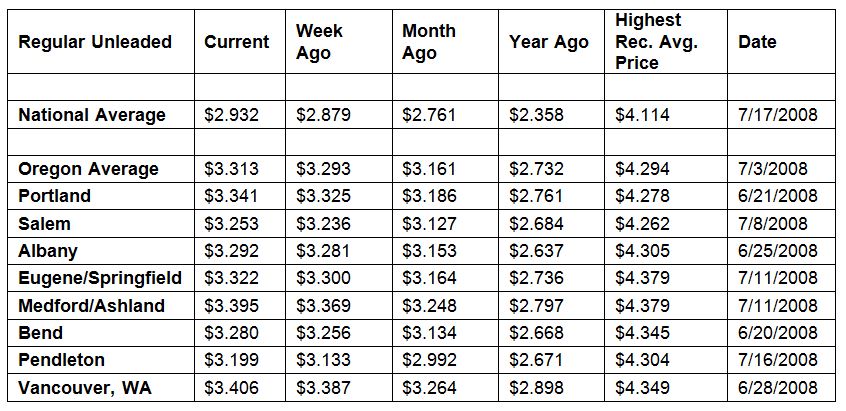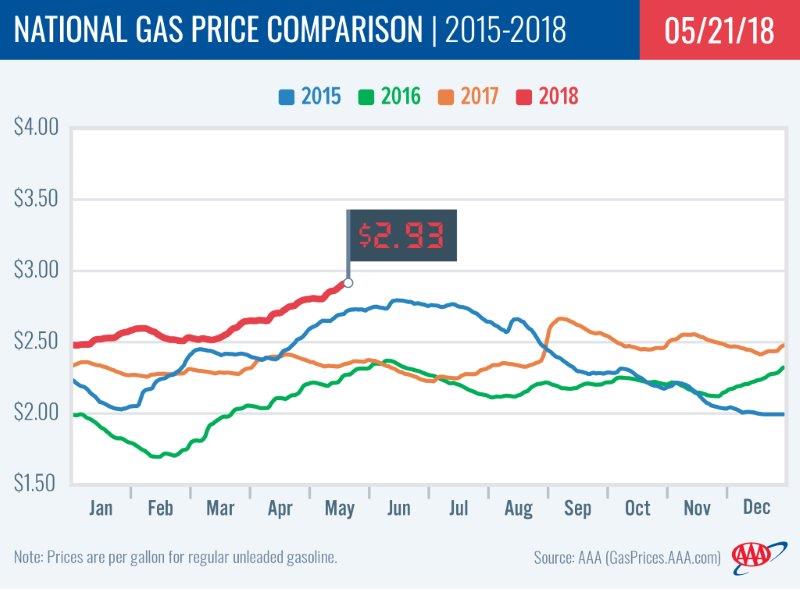PORTLAND, Ore., – Gas prices continue to climb with drivers now paying the highest pump prices leading up to Memorial Day since 2014. For the week, the national average for regular jumps a nickel to $2.93 a gallon, its highest price since November 2014. The Oregon average rises two cents to $3.31, its highest price since October 2014.
AAA projects that 41.5 million Americans will travel this Memorial Day weekend. That’s up 5 percent from last year and the most travelers since 2005. In the Pacific Region, Region (AK, CA, HI, OR, WA), 6.5 million people are expected to travel, a 5.4 percent increase compared to 2017.
Road trips are the most popular way to travel. Nationally, 88 percent of all travelers will drive to their holiday destinations. In the Pacific Region, 84 percent will travel by car. Click here for the news release on AAA’s Memorial Day travel projections.
“Pump prices normally increase in the spring with the switchover to summer blend gas and the start of summer driving. This year additional events are putting upward pressure on prices, including the reinstated Iran sanctions, decreased global supply, increased global demand, expensive crude oil and record U.S. production,” says Marie Dodds, public affairs director for AAA Oregon/Idaho. “AAA now projects that the national average will climb above $3 a gallon this summer. The Oregon average climbed above $3 on March 22 for the first time since August 2015 and has remained there since.”
Oregon is one of 49 states and the District of Columbia reporting week-over-week increases. The largest jumps are in Colorado (+9 cents) and Minnesota (+9 cents). Oregon has one of the smallest weekly increases at two cents, which is the 47th largest in the country. Utah is the only state to see prices fall this week and its average only dropped by four-tenths of a cent.
All 50 states and the District of Columbia have higher prices than one month ago. The national average is 17 cents more and the Oregon average is 15 cents more than a month ago. This is the 34th largest monthly increase in the country. Minnesota (+29 cents) and Wisconsin (+28 cents) have the largest monthly gains.
The West Coast still has the most expensive gas prices in the nation with six of the top ten states in this region. California is most expensive for the fourth week in a row, followed by Hawaii, Washington, Alaska, Nevada and Oregon. Oregon is sixth most expensive for the sixth week in a row. This week 13 states have averages at or above $3 a gallon.
| Rank | Region | Price on 5/22/18 |
| 1 | California | $3.71 |
| 2 | Hawaii | $3.69 |
| 3 | Washington | $3.42 |
| 4 | Alaska | $3.36 |
| 5 | Nevada | $3.32 |
| 6 | Oregon | $3.31 |
| 7 | Idaho | $3.16 |
| 8 | Utah | $3.15 |
| 9 | Connecticut | $3.12 |
| 10 | Pennsylvania | $3.09 |
For the week ending on May 11, the U.S. Energy Information Administration (EIA) revealed that gas stocks on the West Coast fell by approximately 200,000 bbl to 29.7 million bbl. Current inventory levels are 600,000 stronger than they were at the same time last year, with increasing imports helping to buoy inventories. Imports increased by 50,000 bbl to 117,000 bbl last week.
The nation’s cheapest markets are Mississippi ($2.62) and Arkansas ($2.63). For the 42nd week in a row, no states have an average below $2.
Drivers in all 50 states and the District of Columbia are paying are paying more than a year ago to fill up. The national average is 57 cents more and the Oregon average is 58 cents more than a year ago. This is the 21st-largest yearly increase in the country. Utah has the greatest year-over-year increase of 72 cents; Arizona is second at 71 cents; Indiana is third at 68 cents; and California is fourth at 65 cents.
Tips for Consumers
Drivers can find the cheapest gas with the free AAA Mobile app for iPhone, iPad and Android. The app can also be used to map a route, find discounts, book a hotel and access AAA roadside assistance. Learn more at AAA.com/mobile.
According to the AAA Foundation for Traffic Safety’s American Driving Survey, on average, Americans drive 32 miles a day and spend 51 minutes behind the wheel. AAA offers a few ways to conserve fuel:
- Slow down. The faster you drive the more fuel you use. Every 5 mph over 50 mph is like paying an additional $0.18 per gallon, according to the Department of Energy.
- Avoid sudden starts and stops.
- Share work or school rides by carpooling or consider public transportation, bicycling or walking.
- Do not use your trunk or roof for storage. The heavier your car, the more fuel it uses.
- Combine errands. If possible, park in a central spot and walk from place to place.
Oil Market Dynamics
Crude oil prices are at their highest levels since November 2014. Oil prices climbed to new highs for 2018 two weeks ago, following President Trump’s decision to re-impose economic sanctions on Iran and withdraw the U.S. from the Iran Nuclear Deal. Set in 2015 under the Obama Administration, the U.S. – along with the European Union, five permanent members of the UN Security Council, and Germany – entered into the deal that lifted economic sanctions on Tehran in exchange for the country downsizing its nuclear program. Some of the pre-2015 sanctions targeted the Iranian energy sector and impeded Iran’s ability to sell oil. With those sanctions being re-imposed in the next three to six months, Iran’s crude exports are forecasted to decrease, contributing to already declining global crude supplies amid growing global demand. Increased fears of instability in the region may push oil prices even higher this week.
Oil prices edged higher last week following the release of EIA’s weekly petroleum report that showed total crude inventories dropped by 1.4 million bbl. If this week’s EIA report shows another inventory draw, we can expect crude prices to continue climbing.
Additionally, at 2.57 million b/d, crude exports last week saw the highest rate ever recorded by EIA. The new record rate was 690,000 b/d more than the previous week and 1.48 million b/d more than this time last year. The surge in exports is attributed to growth in domestic crude production and Congress and the Obama Administration lifting the 40-year crude export ban in 2015.
Steady growth in crude exports from the U.S. will likely put another spotlight on the crude reduction agreement between OPEC and non-OPEC producers, which is set to expire at the end of 2018. Amid strong global demand and reduced output from OPEC and its partners, including Russia, the U.S. has been able to sell more crude to foreign buyers. Moreover, although the U.S. did not add any active oil rigs last week, according to Baker Hughes, Inc., the current total – 844 – is 124 more rigs than this time last year.
At the close of Friday’s formal trading session on the NYMEX, WTI fell 21 cents to settle at $71.28. At the close of Monday’s formal trading session on the NYMEX, WTI added 96 cents to settle at $72.24. Today crude is trading around $72, compared to $71 a week ago. Crude prices are up about five percent in the last month and are about $22 more per barrel than a year ago.
Diesel
For the week, the national average jumps a nickel to $3.19 a gallon. Oregon’s average adds a penny to $3.38. A year ago the national average for diesel was $2.50 and the Oregon average was $2.68.
Find current fuel prices at GasPrices.AAA.com.
AAA news releases, high resolution images, broadcast-quality video, fact sheets and podcasts are available on the AAA NewsRoom at NewsRoom.AAA.com.




